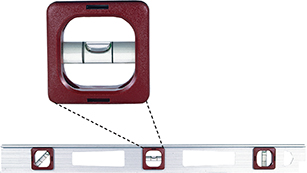3.1 Solids, Liquids, and Gases
Reading Focus
Key Concepts
 How can shape and volume be used to classify materials?
How can shape and volume be used to classify materials? How can kinetic theory and forces of attraction be used to explain the behavior of gases, liquids, and solids?
How can kinetic theory and forces of attraction be used to explain the behavior of gases, liquids, and solids?
Vocabulary
Solid
Liquid
Gas
kinetic energy
Reading Strategy
Comparing and Contrasting Copy the diagram. As you read, replace each letter with one of these phrases: definite volume, definite shape, variable volume, or variable shape.

Do you recognize the object in Figure 1? It is a carpenter's level. A level can be used to see whether a surface is perfectly horizontal. The level has one or more transparent tubes inside a metal or wooden frame. Inside each tube is a clear liquid, such as alcohol, and an air bubble. When a carpenter places the level on a surface that is perfectly horizontal, the air bubble stays in the middle of the horizontal tube. The bubble moves to the high end of the tube if the surface is slanted.
The metal, alcohol, and air in a carpenter's level represent three states of matter. At room temperature, most metals are solids, alcohol is a liquid, and air is a gas. In this chapter, you will learn why the appearance and behavior of solids, liquids, and gases are different.
Figure 1 Carpenters use a level to find out if a surface is perfectly horizontal. In the level shown, three clear plastic tubes are set into an aluminum frame. Each tube contains a liquid and a gas. Classifying What property could you use to distinguish the liquid or gas from the solids in a level?

Describing the States of Matter
If you were asked to classify some materials as solids, liquids, or gases, you would probably find the task fairly easy. But could you describe what method you used to classify the materials? You might notice that some materials have a definite shape and volume and some materials do not. Materials can be classified as solids, liquids, or gases based on whether their shapes and volumes are definite or variable. Shape and volume are clues to how the particles within a material are arranged.
Materials can be classified as solids, liquids, or gases based on whether their shapes and volumes are definite or variable. Shape and volume are clues to how the particles within a material are arranged.




